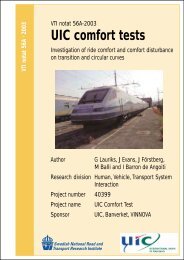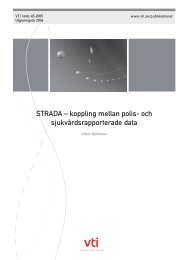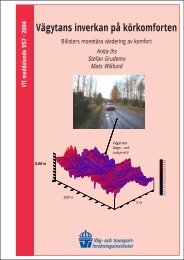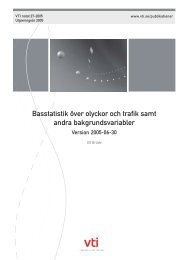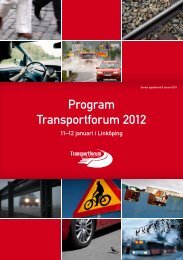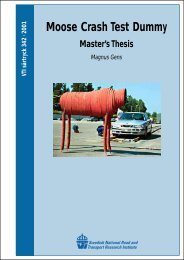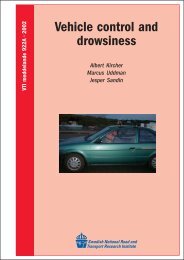Missing text /vti/pages/publication/downloadpdf for sv
Missing text /vti/pages/publication/downloadpdf for sv
Missing text /vti/pages/publication/downloadpdf for sv
You also want an ePaper? Increase the reach of your titles
YUMPU automatically turns print PDFs into web optimized ePapers that Google loves.
Publisher:<br />
Publication:<br />
VTI rapport 791<br />
Published:<br />
2013<br />
Project code:<br />
80724<br />
SE-581 95 Linköping Sweden Project:<br />
GPS controlled salt spreading<br />
Dnr:<br />
2009/0482-28<br />
Author: Sponsor:<br />
Staffan Möller Swedish Transport Administration<br />
Title:<br />
GPS controlled salt spreading. Trial on a test track<br />
Abstract<br />
The purpose of the project is to test and document GPS controlled salt spreading on a test track by<br />
weighing ditributed salt quantities and compare with intended amounts of salt at different spreading<br />
amounts, spreading widths, symmetries, speeds and types of salt (pre wetted salt and brine).<br />
The test is to study how salt distribution is affected by changes in the road section both to the right and to<br />
the left of the through lane or the two through lanes. Such changes should imitate e.g. transition from two<br />
lanes to one on a 2 + 1 road or passing a refuge or a bus-bay. A test track was marked with tape.<br />
In order to measure the spread salt quantities plastic sheets, with the size 1.1 x 1.6 metre, were taped on<br />
the surfacing. Centered over the plastic sheets cloths of curtain fabric, with the size 1.0 x 1.5 metre, were<br />
placed. The cloths were held in place by chains.<br />
When a comparison is made between the salt distribution with and without GPS control of the salt<br />
spreader on two lanes and a bus-bay and on a transition from two lanes to one the following conclusions<br />
are drawn.<br />
Using pre wetted salt on two lanes and a bus-bay at 30 and 45 km/h the results with GPS control got<br />
better on the right lane. On the left lane the results were about the same. Both with and without GPS<br />
control small amounts of salt ended up on the bus-bay.<br />
Using brine on two lanes and a bus-bay at 40 and 65 km/hour the results on the right and left lane respectively<br />
were about the same with and without GPS. On the bus-bay the results with GPS got worse.<br />
Using pre wetted salt on a transition from two lanes to one at 30 and 45km/h the results with GPS control<br />
got worse on the right lane. On the left lane GPS control resulted in higher amounts of salt, but not better<br />
results, compared with without GPS.<br />
Using brine on a transition from two lanes to one at 40 and 65 km/hour the results with GPS control got<br />
better both on the right and the left lane.<br />
Keywords:<br />
Salt spreading, GPS, test<br />
ISSN: Language: No. of <strong>pages</strong>:<br />
0347-6030 Swedish 62



